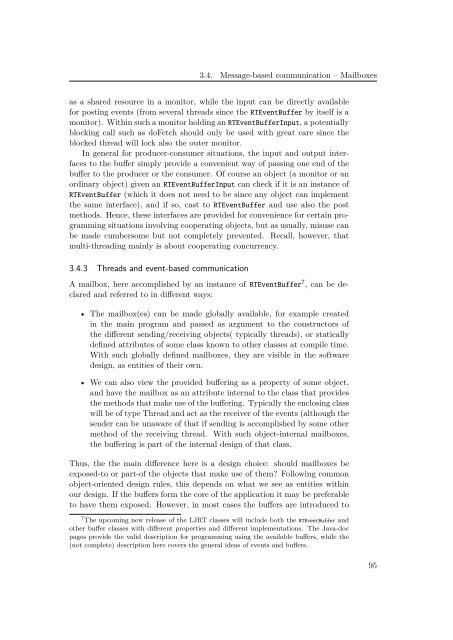JAVA-BASED REAL-TIME PROGRAMMING
JAVA-BASED REAL-TIME PROGRAMMING
JAVA-BASED REAL-TIME PROGRAMMING
Create successful ePaper yourself
Turn your PDF publications into a flip-book with our unique Google optimized e-Paper software.
3.4. Message-based communication – Mailboxes<br />
as a shared resource in a monitor, while the input can be directly available<br />
for posting events (from several threads since the RTEventBuffer by itself is a<br />
monitor). Within such a monitor holding an RTEventBufferInput, a potentially<br />
blocking call such as doFetch should only be used with great care since the<br />
blocked thread will lock also the outer monitor.<br />
In general for producer-consumer situations, the input and output interfaces<br />
to the buffer simply provide a convenient way of passing one end of the<br />
buffer to the producer or the consumer. Of course an object (a monitor or an<br />
ordinary object) given an RTEventBufferInput can check if it is an instance of<br />
RTEventBuffer (which it does not need to be since any object can implement<br />
the same interface), and if so, cast to RTEventBuffer and use also the post<br />
methods. Hence, these interfaces are provided for convenience for certain programming<br />
situations involving cooperating objects, but as usually, misuse can<br />
be made cumbersome but not completely prevented. Recall, however, that<br />
multi-threading mainly is about cooperating concurrency.<br />
3.4.3 Threads and event-based communication<br />
A mailbox, here accomplished by an instance of RTEventBuffer 7 , can be declared<br />
and referred to in different ways:<br />
• The mailbox(es) can be made globally available, for example created<br />
in the main program and passed as argument to the constructors of<br />
the different sending/receiving objects( typically threads), or statically<br />
defined attributes of some class known to other classes at compile time.<br />
With such globally defined mailboxes, they are visible in the software<br />
design, as entities of their own.<br />
• We can also view the provided buffering as a property of some object,<br />
and have the mailbox as an attribute internal to the class that provides<br />
the methods that make use of the buffering. Typically the enclosing class<br />
will be of type Thread and act as the receiver of the events (although the<br />
sender can be unaware of that if sending is accomplished by some other<br />
method of the receiving thread. With such object-internal mailboxes,<br />
the buffering is part of the internal design of that class.<br />
Thus, the the main difference here is a design choice: should mailboxes be<br />
exposed-to or part-of the objects that make use of them? Following common<br />
object-oriented design rules, this depends on what we see as entities within<br />
our design. If the buffers form the core of the application it may be preferable<br />
to have them exposed. However, in most cases the buffers are introduced to<br />
7 The upcoming new release of the LJRT classes will include both the RTEventBuffer and<br />
other buffer classes with different properties and different implementations. The Java-doc<br />
pages provide the valid description for programming using the available buffers, while the<br />
(not complete) description here covers the general ideas of events and buffers.<br />
95

















